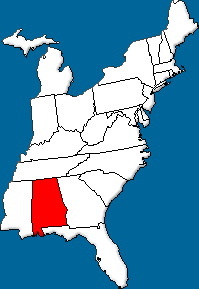 History:
The first European to explore Alabama was Alonzo Alvarez de Pineda of Spain, who explored the Gulf of Mexico from Florida to Mexico in 1519, including the area we now call Mobile Bay. The Spaniard Panfilo de Narvaez attempted to start a colony in 1528 along the Florida Gulf Coast, but was unsuccessful. Hernando de Soto, also from Spain, explored the Southeast, coming into conflict with Chief Tuskaloosa in the Battle of Maubila in 1540. De Soto destroyed the Indian village and most of its more than 2,000 residents. Another Spaniard, Don Tristan de Luna failed to establish a permanent Spanish colony on the Alabama Florida coast between 1559 and 1561.
In 1702, Iberville and Bienville Le Moyne, brothers from France, established a fort and settlement at Twenty-seven Mile Bluff. By 1712, the settlement was moved downriver to Mobile. In 1717, the French built another settlement, called Fort Toulouse, on the Coosa River. The settlement was designed to facilitate trade with the Indians and to counter the British influence that was growing in the area.
In 1721, the slave ship Africane arrived in Mobile with over 100 slaves. Slavery was introduced in the area under the French "Code Noir" (black law) brought from the French West Indies to the North American colonies.
During the American Revolution, the Spanish captured Mobile and retained control of the area as part of the treaties ending the war. It was not until 1799, when US troops under Lt. John McClary took possession of Fort St. Stephens from the Spanish, that the US flag was raised for the first time on Alabama soil. The majority of the area remained under Spanish control. In 1802, Georgia formally gave up land south of the 31st parallel, leaving the area as part of what would become Alabama.
As the number of white settlers increased in the early nineteenth century, the Creek Indians were divided in their reaction to the encroachment. Some had become more assimilated through contact with whites, but those who held more traditional views rallied behind Tecumseh, a great Shawnee leader from the North. Just before the War of 1812, Tecumseh traveled south from the Great Lakes region to try and unite all Native Americans against white settlers. The division between the two groups of Creeks led to the Creek War of 1813-14, which was part of the War of 1812. The Creeks under Tecumseh were supported by both Spain and England and fought against the Americans. The Americans were led by General Andrew Jackson, who was allied with the Choctaw, Chickasaw and Cherokee. The Creek War ended in 1814 when the Creeks signed the Treaty of Fort Jackson, giving up over 40,000 square miles of land. Despite the fact that the Choctaw, Chickasaw and Cherokee were allied with US troops, they too were eventually forced from their land.
In 1817, the US Congress established the Alabama Territory. In 1819, Alabama was admitted as the 22nd state of the Union. By 1850, the population of Alabama included 426,000 whites and 343,000 slaves. In 1861, the Alabama Secession Convention declared Alabama a state independent from the United States, making it the fourth state to secede from the Union. During the Civil War, there were 194 land battles and 8 naval engagements on Alabama soil. Alabama was not readmitted to the Union until 1868.
Reconstruction was difficult throughout the South, but during the late nineteenth century the economy of the state slowly improved with industrialization. At Tuskegee Institute, founded in 1881 by Booker T. Washington, Dr. George Washington Carver carried out his famous agricultural research.
During the 1950s and 1960s, the South experienced serious racial problems. Segregation kept whites and blacks separate. Martin Luther King Jr. led a boycott of buses in Montgomery. Rosa Parks was arrested for refusing to give up her seat to a white passenger. Even with federal laws ruling segregation unconstitutional, the National Guard was called upon many times to enforce the law in Alabama. Segregation did not completely end in Alabama until the 1980s. |









